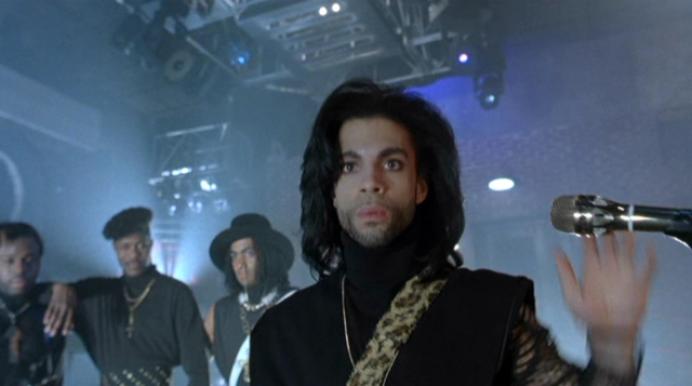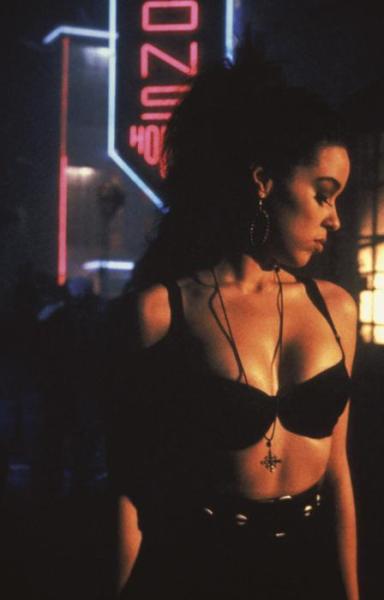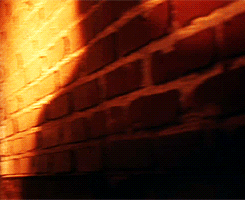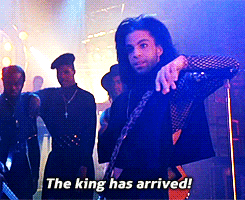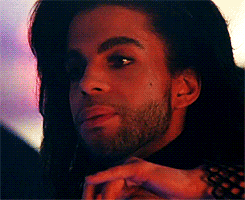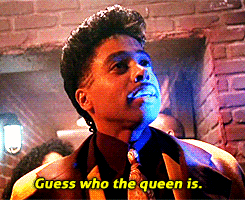| |
- E-mail - orgNote -  Report post to moderator Report post to moderator |
| |
- E-mail - orgNote -  Report post to moderator Report post to moderator |
Yes, it's a bad movie, but I just love this era/album!
During filming of "Graffiti Bridge," I worked at a grocery store by Flyte Tyme. One lunch hour, Jimmy Jam came in. Super nice guy! I asked him about "Graffiti Bridge," and he said, "Prince has his vision, and we try not to question it." He said it with respect and no malice or judgment.
Given the movie, perhaps they should have questioned it. "She made me glad to be a man" | |
- E-mail - orgNote -  Report post to moderator Report post to moderator |
I'm probably one of the minority of people on here that actually enjoys the movie. I like it, I like how musicallish it is and the fantasy feel it has to it. I sorta wish I could go to seven corners and just go to one of the clubs for the night. I'd go to The Kids club obviously, haha. | |
- E-mail - orgNote -  Report post to moderator Report post to moderator |
I'm sorry to disparage the movie. I'm so glad you like it!! I wish I did. Maybe I should watch it again. I sure do love the music! "She made me glad to be a man" | |
- E-mail - orgNote -  Report post to moderator Report post to moderator |
Absolutely not, the song is very similar to the version on CW, pre-The Time (full band), which itself was a reworking of the original 1983 recording. The track, as all 5 Prince tracks on Pandemonium, was recorded by Prince. The band only remixed/overdubbed/edited the 5 Prince songs (to more or less extent: for example Jerk Out was severely reworked while Chocolate or Donald Trump were left almost intact) when they took control of the project. It's pretty obvious when u listen to the demos and compare them to the released versions. [Edited 3/18/15 13:56pm] A COMPREHENSIVE PRINCE DISCOGRAPHY (work in progress ^^): https://sites.google.com/...scography/ | |
- E-mail - orgNote -  Report post to moderator Report post to moderator |
The We Can Funk version in the movie with the meowing, has that ever been available? | |
- E-mail - orgNote -  Report post to moderator Report post to moderator |
No but u can rip the audio tracks from the DVD. A COMPREHENSIVE PRINCE DISCOGRAPHY (work in progress ^^): https://sites.google.com/...scography/ | |
- E-mail - orgNote -  Report post to moderator Report post to moderator |
ah ok, thanks for the info | |
- E-mail - orgNote -  Report post to moderator Report post to moderator |
http://www.notcoming.com/...itibridge/
Graffiti Bridge
Purple Rain began with a sermon (“Dearly beloved…I’m here to tell you, there’s something else…the afterworld”). Graffiti Bridge begins with a manifesto. On stage in his own club, the Glam Slam, Prince’s alter-ego “The Kid” now leads a new revolution: “We are the New Power Generation / We want 2 change the world. / The only thing that’s in our way is you.” These lyrics aptly express the film’s general atmosphere of embattled ecstasy, obsessed with the studio-wizard’s power and with Prince’s place in the generational tale of pop music’s evolution. The obstructive “you” could, in this case, be nearly anyone, from the management team that Prince fired shortly before taking the reins as director of his own script, to the rival bands that he both cultivated and competed with, to the audience that he felt was slipping away after the commercial failure of recent projects like Under the Cherry Moon and the shelved Black Album. “You” is anyone unsexy, unsaved, or uncooperative. Set some time after the events of Purple Rain (though not originally intended as a sequel), Graffiti Bridge finds Morris Day and The Kid as co-owners of a club in Minneapolis, with opposing views on how to run the place. Nightly, the two wage funky civil war, sampling each other’s taunts and spinning them into rave-up improvisations. Also in the mix is a beautiful spirit-guide named Aura, who finds herself caught in a kind of salvation-triangle with the two male leads and who narrates the central conflict in voice-over: “2 souls fight. 1 wants money, 1 wants light.” Economically, none of this makes a lot of sense: Day, in all his bombastic hedonism, is setting out to sabotage a club that he partly owns. He spits about how spiritual music isn’t hip and won’t make money, but we’ve just seen a jam-packed club getting hyped to the New Power Generation, and we will soon see Day’s own joint pumping Prince’s music. But Graffiti Bridge is a lot more fun than its reputation as a fiasco would suggest, and its bizarre tone—openly combative, while praying for détente—can tell us a lot about how Prince understood the shape of things to come in 1990. Purple Rain retold rock’s archetypal tale: a talented outsider rises up to become a star. Graffiti Bridge is about a managerial dispute. It’s about as cool as prolonged arbitration between established acts can hope to be. So while Graffiti Bridge’s status as a “sequel” may be tenuous, the movement between the two films nevertheless maps, in broad terms, the trajectory of Prince’s career into an increasingly litigious decade. But noting this contrast between aspiration and contract negotiation hardly begins to explain the perverse and systematic ways that Graffiti Bridge eschews every non-musical element that lent Purple Rain its necessary pathos. Here we see The Kid penning a letter to his late father – Rain’s bogeyman of failed musical dreams and spousal abuse – still worried that he will wind up like him. But before we can hear a dove so much as whimper, this tender epistolary moment is interrupted—“yo Kid, you gotta come upstairs and see this!” Kid crumples his draft in favor of smirking at little Tevin Campbell (Quincy Jones’s 13 year old protégé) jamming out on “Round and Round” street-side. Though The Kid later prays to Dad above, revealing a pistol tucked in his desk drawer as he suggests he might “take the easy way out like you did,” the only dramatic pay-off is our discovery of Prince’s twist on Chekov’s famous dictum: “if U introduce a gun in act 1, that gun has 2 B dropped in a shallow, fake pond in a throwaway scene somewhere near the end.” Such a deliberate muting of the dramatic stakes is as much a product of our funky cold messiah’s piety as of his impatience to get to the next performance. (I stopped counting, but I think there are about 17 performance scenes in all—comprising the majority of the movie-as-music-video-compilation.) Prince pointed out to Neal Karlen in a 1990 Rolling Stone interview that Graffiti Bridge was “a different kind of movie. It’s not violent. Nobody gets laid.” Prince had always mingled the sacred and the carnal: feel the sweat lashing off “The Cross” (on Sign “O” the Times) and other songs that draw on his Seventh-Day Adventist upbringing for their call-and-response fervor and millennial shadows. But here we see him more publicly embracing his faith without euphemism or coyness. This explains somewhat why Kid and Aura recite religious poetry at one another before dry humping on a motorcycle. Nowhere is the “nobody gets laid” program more heavy-handed than in the montage of their budding flirtation, in which the two take turns almost biting an apple in the Edenic space beneath Graffiti Bridge.1 But this raises the question: what is Prince without sin? How can we hope for redemption without at least someone getting laid? For one thing, we might think of how Graffiti Bridge salvages the city of Minneapolis, pictured here as a dilapidated Babylon. Though the movie is named after a suburban Twin Cities landmark that was about to be torn down by the time filming began – a bridge that became a palimpsest of anti-Vietnam war slogans and peace signs in the late 1960s – Graffiti Bridge was shot almost exclusively on a soundstage at Paisley Park in nearby Chanhassen, MN. Titled after a location that was facing demolition, the film retreats indoors, finding a site for reconstruction and social connection in a fantasy city that looks like nothing so much as a New Jack Disneyland. No matter that the rebuilt graffiti bridge in the movie looks like it’s made of Styrofoam and plywood; Prince freely admitted that his sets were cheap. However cheesy the result, the film does invite viewers onto a playground version of Minneapolis’s famed Seven Corners, an intersection whose history mirrors the crossroads of Prince’s own amalgamated sound. Here, near to the West Bank of the Mississippi, Lester Young played at the black and tan South Side Ballroom, Bob Dylan journeyed across the river to perform his earliest club gigs, and a growing cadre of beats, folkies, and hippies would earn the Corners an identity as the “Haight-Ashbury of the Midwest.” When, a full 27 minutes in, we finally get our first non-soundstage shot—a brief glimpse of the real Minneapolis—it comes as a shock. Oh right…the real world. In between Purple Rain’s titanic success and Graffiti Bridge bombing at the box office, a number of key moments in black popular culture can suggest why the two movies’ twin cities seem so stylistically distant from one another. In particular, Prince clearly took cues from the vibrancy of Ernest Dickerson’s cinematography for Spike Lee’s School Daze (1988) and Do the Right Thing (1989), and he must have been leaning in close to watch the Fred Astaire soundstage musical homage in Michael Jackson’s “Club 30” sequences for the short film Smooth Criminal (1988). When Prince told Rolling Stone that he was “not looking to be Francis Ford Coppola,” he probably had in mind the romantic, neon-lit artifice of One From the Heart (1982) (with a jealous glance at Coppola and Jackson’s Captain Eo, made for Disneyland in 1986). But surely the most important contemporary influence on Graffiti Bridge is Tim Burton’s 1989 Batman, for which Prince composed and performed several songs. During filming, Prince had frequently hung around watching Burton on set, marveling at how he negotiated Warner Brothers’ demands. In addition to the fact that many of the songs for Graffiti Bridge originated in the Batman sessions, Prince first tapped then-girlfriend Kim Basinger (whose sampled erotic moans he would rework into a remix called “The Scandalous Sex Suite”) for the film’s female lead. He and Basinger split after writing a treatment for the movie together, but Prince remained hot for Gotham. It’s no surprise, then, that the drama of Graffiti Bridge plays out as if it exists on a side street of Tim Burton’s Pop-Expressionist version of the city, while pointing forward to the garish hoopla of Joel Schumacher’s. If Prince’s Batman album added nipples to the batsuit years before Schumacher got there, Graffiti Bridge seems to want to build a “Gotham city for the ghetto,” as R. Kelly would later sing on a remix of his own contribution to the Batman and Robin soundtrack.2 Blown up to such a superheroic scale, the old rivalry between The Kid and Morris Day transcends Minneapolis scene politics for a true good-and-evil rivalry. Playing the wily villain, Morris is now a full-fledged peacock-pimp apostate angel, first seen eating hot peppers that send his weaker minions running for water, and later glimpsed pissing on a fern in the Glam Slam and then somehow lighting the pissy fern on fire. Day lords over his half of the club, Pandemonium, a thronged and spacious hall that crackles with pyrotechnics when the Time plays “Shake.” Like Milton’s Satan, Morris Day gets all the best lines (“See this? Take a week off and kiss it all”). The Kid, clean-shaven in Purple Rain, now rocks a stylized beard, his long hair pressed into a kind of bouffant cowl. (Who knows what evil lurks in the souls of men? The 5 O’clock Shadow knows!) In place of a Batcave, The Kid seems most at home in his studio apartment (the word “studio” designating both size and function), which looks like the pad you might envision in a dream in which you invented AOL on a submarine. We begin and end the film in his personal editing bay, which announces his knob-fiddling control both in front of and behind the cameras. Ever the maestro, Prince apparently secured his cast by giving different participants different pictures of what the film would be. Having fired Jimmy Jam and Terry Lewis from his touring company back in 1983, he convinced them and the rest of the original line-up of The Time to reunite for the movie, telling the band that this sequel would finally offer their side of the story. Jam and Lewis certainly didn’t need to return: The duo had, in the intervening years, become major producers in their own right, masterminding Janet Jackson’s 1986 mega-selling Control. Singles such as “Nasty” proved to be a major influence on the marriage of R&B and rap that a young musician/producer named Teddy Riley, working with artists like Keith Sweat and Bobby Brown, would turn into the dominant sound of pop in the early 90s. In a 1988 Village Voice profile of Riley, Barry Michael Cooper would coin the genre “New Jack Swing,” and describe Riley, an heir apparent to Prince’s throne, as a man who “exuded a gangster’s confidence, but he also had a scholarly self-absorption about him, like Kant mesmerized by the church’s steeple.” “If Hendrix, Brown, Stone, and Gaye are the starting point, and Prince the bridge, Teddy Riley is the other side,” Cooper declared (emphasis added). So this is one clear meaning of the movie’s title: Prince is resetting the clock, and redeeming the Time, in order to reassert himself as the sanctified link between the likes of George Clinton and Mavis Staples—the old power generation—and the ascendant New Jack producers du jour. Clinton, the P-Funk all-star, gets his own club in the movie, just down the block from Glam Slam, and Mavis plays the part of “Melody Cool” performing a strutting number of the same name (“I’ve seen a million bridges in my time, and crossed every one of them, with no trouble at all…I’m still Melody, and I’m still Cool”). In tension with the generosity of these cameos, Graffiti Bridge is an attempt to narrate the artificial process by which the studio creation becomes a disciple. That process is closest to the surface in the character of Aura, the muse figure played by Ingrid Chavez, a Mexican-American poet and lyricist who would later co-write Madonna’s “Justify My Love.” While Apollonia’s role on the sidelines of Purple Rain had already displayed Prince’s tendency to use and abuse his female collaborators as props, at least she was a real physical being in the movie’s world (luridly so). As Bridge’s “spirit child” and object of quasi-romantic competition between The Kid and Morris Day, Aura is a more malleable and disembodied figure. She frequently disappears into thin air, reappears when needed in new costumes, and leaves white feathers lingering on the breeze.3 As sleepy as her performance is, Chavez proves the perfect female lead for Prince’s thin plot: a manic pixilated dream girl who he can fade in and out of the mix as necessary—sometimes vampy, sometimes virtuous. She is the reflexive muse that is, in practice, Prince programming his own inspiration; if no one is getting laid, it’s because our savior is always busy playing with himself. But narcissistic Christ-like poses are par for the course in Prince’s filmography (one could even say they are the course). What’s strange about Graffiti Bridge isn’t that Prince casts himself as a savior but that his savior figure rarely converts his audience. I mean, while Prince throws a rock tantrum with the lascivious “Tick, Tick, Bang,” the words “BEAT ME” tattooed inside a heart on his bare chest, one member of the Time is actually seen playing a Game Boy. This self-consciousness about losing his crowd is played as farce, but is clearly deeply felt. The idea that Prince, at any point after 1979, would fail to attract more audience members than he has guitar strings—and with these songs—is the least believable part of a movie in which Morris Day very nearly date-rapes an angel. And yet even the final chorus of the converted, who are at last revived and awed by The Kid’s triumphant performance, can’t truly erase an entire film’s worth of self-flagellating anxiety about a market that was beginning to cast Prince aside. “Still Would Stand All Time,” the gospel-inflected slow-jam that brings the film to climax, is no “Purple Rain,” but it does the trick. As a member of the vanquished Time marvels, “Can you believe it? The Kid won! And with a ballad! Damn…” Well, yeah. You saw the first movie, right? So what if this self-conscious deus ex studio admits Prince’s final coup to be a little artificial? Lighters up, party people; we’re kicking off the 90s with a vigil.
By Greg Londe ©2013 NotComing.com
| |
- E-mail - orgNote -  Report post to moderator Report post to moderator |
| |
- E-mail - orgNote -  Report post to moderator Report post to moderator |
| |
- E-mail - orgNote -  Report post to moderator Report post to moderator |
I remember going to see this movie at the theater with a non-fan friend of mine. There were about 8 - 12 people there and the film was embarrassing, especially for someone like me trying to convince my musician friend that Prince kicks ass. He liked the music well enough but when we walked out he said, "Dude, where the hell is Prince coming from?" I thought that was funny.
I haven't busted out Pandemonium in a while. Time (heh) to give that one a fresh listen. I remember really liking it at the Time (heh). See what I did there? | |
- E-mail - orgNote -  Report post to moderator Report post to moderator |
LOVE THE SOUNDTRACK! This, SOTT, The Black Album, and the 3 disc Crystal Ball was Prince emptying the good stuff in the mythical vault . I'm sick and tired of the Prince fans being sick and tired of the Prince fans that are sick and tired! | |
- E-mail - orgNote -  Report post to moderator Report post to moderator |
- E-mail - orgNote -  Report post to moderator Report post to moderator |
- E-mail - orgNote -  Report post to moderator Report post to moderator |
Jerk out #1 (lead vocals by [Prince]) Jerk out #2 (lead vocals by Mazarati) (7:07) [lyrics] Jerk out #3 (6:49) Jerk out #3 (w/different intro) (7:12) Jerk out #3 (a capella) (2:28) Jerk out #3 (edit) (3:56) Jerk out #3 (mo' jerk out) (4:36) Jerk out #3 (sexy dub) (7:14) Jerk out #3 (sexy edit) (4:36) Jerk out #3 (sexy instrumental) (7:02) Jerk out #3 (sexy mix) (8:55)
| |
- E-mail - orgNote -  Report post to moderator Report post to moderator |
Band.
| ||
- E-mail - orgNote -  Report post to moderator Report post to moderator |
Jerk out #2 (6:57) (lead vocals by Mazarati:Sir Casey Terry) I got real bored on a friday night, I couldn't find a damn thing to do.
| |
- E-mail - orgNote -  Report post to moderator Report post to moderator |
| |
- E-mail - orgNote -  Report post to moderator Report post to moderator |
September 1990 Paramount Studio LA Arsenio Hall Show musical guests: the Time 1.) Jerk Out
| |
- E-mail - orgNote -  Report post to moderator Report post to moderator |
tale end of the GB era pre Diamonds & Pearls
| |
- E-mail - orgNote -  Report post to moderator Report post to moderator |
I saw The Time on Video Soul,before the movie came out,and host Donnie Simpson asked them about the movie.Jimmy Jam was quick to point out,"We appear in the film,but we didn't write it" | |
- E-mail - orgNote -  Report post to moderator Report post to moderator |
I don't think that scene made the final cut. | |
- E-mail - orgNote -  Report post to moderator Report post to moderator |
It's an outtake image, there was another scene with Jill and Morris I posted that didn't make it. And of course the Hanging Man scene. Jill again get's the raw deal in this one lol I didn't realize when I first saw it that her Jill lip synced to Love Machine ( lead vocals Elisa Fiorillo )
| |
- E-mail - orgNote -  Report post to moderator Report post to moderator |
lol people ran from that movie. That movie broke up the Lovesexy band lol jk I would have loved a Time movie. I always thought Under the Cherry Moon would have been a perfect Time movie
| |
- E-mail - orgNote -  Report post to moderator Report post to moderator |
UTCM would have been totally perfect for The Time!!! "She made me glad to be a man" | |
- E-mail - orgNote -  Report post to moderator Report post to moderator |
I love threads like this. Just curious, Oldfriends....... where do you get all your images and articles/info from? Do you have a scrapbook or something? | |
- E-mail - orgNote -  Report post to moderator Report post to moderator |
I always thought that this picture was Batman into GB because he is clean shaven? | |
- E-mail - orgNote -  Report post to moderator Report post to moderator |
I did too. I've asked around the org but no one ever answers. I still have this pictur from the magazine it came from, I believe Interview mag this ^ picture from the website could be wrong in saying 1991 But I know the article came sometime in the earliy 90s But like some photos during that time, he also used some Lovesexy shots Do you think it's more Batman-Graffiti Bridge? Looks like he has the same styled yellow pants in the first picture post #1
Here he is below with facial hair late 1989
| |
- E-mail - orgNote -  Report post to moderator Report post to moderator |
 New topic
New topic Printable
Printable





